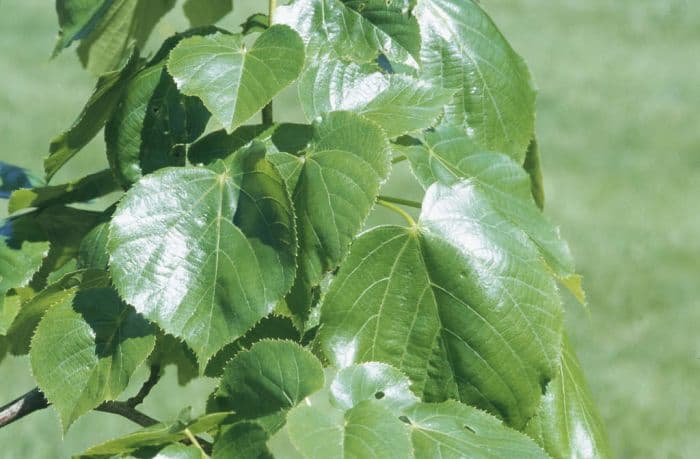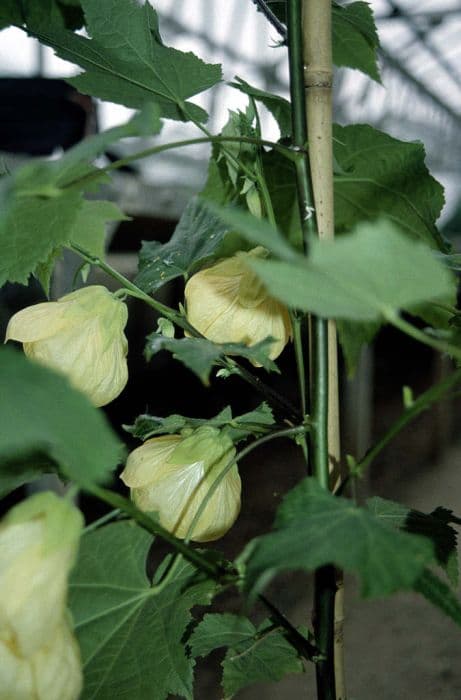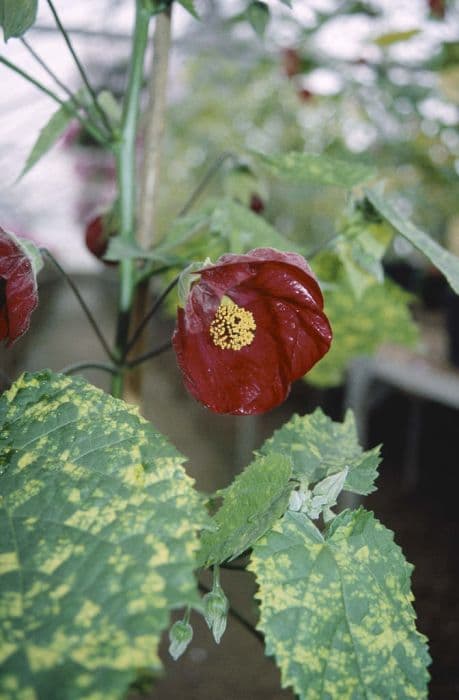Crimean Linden Tilia × euchlora

ABOUT
Tilia × euchlora, commonly known as the Crimean Linden, is an attractive deciduous tree that is noted for its beautiful foliage and pleasant form. It possesses heart-shaped leaves that are glossy and dark green in color, with a more pale underside. In the spring and summer, the leaves create a dense and lush canopy that provides ample shade. During the autumn, the foliage may turn a pale yellow, adding seasonal interest to the landscape. The Crimean Linden is also admired for its highly fragrant, pale-yellow flowers that typically bloom in early summer. These small, star-shaped flowers hang in clusters attached to a leafy, pale yellow-green bract that stands out against the foliage. Following the flowering period, the tree produces small, roundish nutlets that are attached to a narrow wing-like structure, or bract, which aids in wind dispersal. The bark of the Crimean Linden is grey-brown and can become quite fissured with age, giving the trunk a rugged appearance. This tree is often planted for its ornamental appeal and its ability to attract bees and other pollinators because of its sweet-scented flowers.
About this plant
 Names
NamesFamily
Malvaceae
Synonyms
Crimean Linden, Caucasian Lime
Common names
Tilia × euchlora.
 Toxicity
ToxicityTo humans
The Crimean Linden (Tilia × euchlora) is generally not considered toxic to humans. There are no well-documented cases or significant concerns regarding its toxicity when it comes to ingestion by humans. Therefore, there is no list of poisoning symptoms associated with the Crimean Linden, as it is typically safe for human consumption in moderation, such as in the form of linden tea which is commonly made from the flowers of linden trees.
To pets
The Crimean Linden (Tilia × euchlora) is not known to be toxic to pets. This plant does not appear on the lists of toxic plants for dogs, cats, or other domestic animals. Therefore, it is not expected to cause poisoning if pets were to ingest parts of the plant. There are no specific symptoms associated with Crimean Linden poisoning, as it is generally considered to be non-toxic to animals.
 Characteristics
CharacteristicsLife cycle
Perennials
Foliage type
Deciduous
Color of leaves
Green
Flower color
Yellow
Height
50 feet (15 meters)
Spread
35 feet (10.7 meters)
Plant type
Tree
Hardiness zones
5
Native area
Hybrid
Benefits
 General Benefits
General Benefits- Shade Provider: Tilia × euchlora, commonly known as Crimean Linden, has a wide canopy that provides ample shade, making it ideal for parks and large gardens.
- Aesthetic Appeal: The tree offers ornamental value with its attractive foliage, flowers, and form, enhancing the landscape visually.
- Wildlife Habitat: It serves as a habitat and food source for various wildlife species, including bees, birds, and butterflies.
- Noise Reduction: Crimean Linden can help reduce noise pollution when planted in rows or as part of a hedge along streets or highways.
- Windbreak: Its dense foliage and strong branches can act as a windbreak, protecting smaller plants and reducing soil erosion.
- Urban Tolerant: Crimean Linden is resilient to urban conditions, such as pollution and confined spaces, making it suitable for city planting.
- Seasonal Interest: Offers seasonal interest with its fragrant flowers in spring and vibrant leaf color change in the fall.
 Medical Properties
Medical Properties- Sedative: Common lime may be used in herbal medicine for its potential sedative and calming effects, which might help alleviate anxiety and promote sleep.
- Antispasmodic: The plant’s components may have antispasmodic properties, providing potential relief from muscle cramps and spasms.
- Diaphoretic: Tilia × euchlora is traditionally believed to induce sweating, which can be seen as a way to reduce fever naturally.
- Expectorant: The plant may act as an expectorant, helping to loosen phlegm in the respiratory passages and making it easier to cough up.
- Mucilaginous: Because of its mucilage content, the plant may soothe irritated mucous membranes, hence providing relief from sore throats and coughs.
 Air-purifying Qualities
Air-purifying QualitiesThis plant is not specifically known for air purifying qualities.
 Other Uses
Other Uses- Crafting Material: The wood of the Crimean Linden is suitable for carving and woodworking, creating small decorative items and intricate wooden crafts.
- Street Trees: Crimean Lindens are planted along streets for their tolerance to pollution and ability to thrive in urban settings.
- Shade Provider: With its canopy of dense foliage, it's often planted in parks and large gardens to provide cool, shaded areas during hot summers.
- Honey Production: Bees are attracted to its flowers; hence, it can be strategically planted to boost local honey production with its unique flavor.
- Landscape Architecture: Crimean Linden is used in formal landscape designs, often pruned into geometric shapes for aesthetic purposes.
- Wildlife Habitat: Its dense branches and foliage offer shelter and nesting sites for birds and other small wildlife.
- Sound Barrier: The tree can be used as a natural sound barrier when planted in rows along highways or noisy areas.
- Edible Flowers: The flowers, while not commonly eaten, can be used to make herbal teas or to add flavor to dishes.
- Dye Production: The leaves and bark can be used to create natural dyes for textiles.
- Educational Tool: The Crimean Linden can be used in educational settings to teach about tree biology, dendrology, and environmental importance.
Interesting Facts
 Feng Shui
Feng ShuiThe plant Crimean Linden is not used in Feng Shui practice.
 Zodiac Sign Compitability
Zodiac Sign CompitabilityThe Crimean Linden is not used in astrology practice.
 Plant Symbolism
Plant Symbolism- Love: Often associated with love and romance, the Crimean Linden is a plant that is traditionally used to express affection and can be found in love-related folklore and customs.
- Peace: The tranquil and gentle aspect of the tree conveys a sense of peace and is sometimes planted in places meant for reflection or remembrance.
- Fertility: With its lush leaves and frequent flowering, the Crimean Linden is symbolically linked to fertility and the abundance of life.
- Healing: The tree's medicinal properties, particularly its soothing effect for colds and respiratory problems, lend it a reputation as a symbol of healing and nurturing.
 Water
WaterThe Crimean Linden (Tilia × euchlora) should be watered deeply and thoroughly, allowing the soil to become moist but not soggy. Young trees benefit from watering once a week, particularly during dry spells, with approximately 1 to 1.5 gallons per watering session. Mature trees, on the other hand, may only require additional water during prolonged droughts. It is crucial to ensure that the soil around the tree dries out somewhat between watering sessions to prevent overwatering, which can lead to root rot. Adjust the frequency of watering based on weather conditions, watering more frequently during hot, dry periods and less during cooler, rainy spells.
 Light
LightCrimean Linden prefers full sun to partial shade, thriving best in a location where it receives at least four to six hours of direct sunlight per day. It can tolerate a bit of shade, especially during the hottest part of the day, which can be helpful in preventing leaf scorch in regions with very intense summer sun. Thus, choosing a spot with adequate morning sunlight but some afternoon protection can be ideal.
 Temperature
TemperatureCrimean Linden is hardy and adaptable but prefers temperate climates. It can survive in a temperature range between 20°F and 80°F, though its ideal growing temperatures are between 50°F and 70°F. Extreme temperatures, both high and low, can be detrimental to the plant, so planting it in a location that avoids temperature extremes is beneficial.
 Pruning
PruningPrune the Crimean Linden to maintain its shape and remove any dead or damaged branches, which can be done in late winter or early spring before new growth starts. Pruning may be carried out every 2 to 3 years, and it is also important to thin out dense branches to allow light and air to penetrate the canopy, encouraging healthy growth. Such maintenance helps prevent disease and promotes a strong structure.
 Cleaning
CleaningAs needed
 Soil
SoilCrimean Linden prefers well-draining, fertile soil with a pH of 6.0-7.5. A mix of loam, peat, and sand in equal parts is ideal to maintain the right balance of moisture and aeration.
 Repotting
RepottingCrimean Linden trees are typically large and do not require regular repotting; they are usually planted directly in the ground.
 Humidity & Misting
Humidity & MistingCrimean Linden thrives in average outdoor humidity levels and does not require any special humidity adjustments.
 Suitable locations
Suitable locationsIndoor
Crimean Linden is not suitable for indoor growth due to its size.
Outdoor
Plant in well-draining soil with full sun to partial shade.
Hardiness zone
5-9 USDA
 Life cycle
Life cycleTilia × euchlora, commonly known as the Crimean Linden, begins its life cycle as a seed, typically germinating in the presence of suitable soil, warmth, and moisture conditions. Following germination, the seedling emerges and establishes a root system, while above ground, a shoot develops into a sapling with characteristic heart-shaped leaves. As it matures, the sapling undergoes a period of rapid growth, eventually forming a sturdy trunk and a spreading canopy, characteristic of the Crimean Linden. The tree reaches reproductive maturity and begins its flowering stage, producing fragrant, cream-colored flowers that are attractive to bees, resulting in pollination. After successful pollination, fruits develop which are small nutlets attached to a leafy bract, aiding in their dispersal by wind. Throughout its life, the Crimean Linden may experience multiple cycles of flowering and fruiting annually, with individual trees living for several hundred years if conditions are favorable.
 Propogation
PropogationPropogation time
Spring-early summer
The Crimean Linden, or Tilia × euchlora, is often propagated by taking semi-hardwood cuttings in the late summer. The process involves selecting a healthy branch of the current or previous year’s growth and cutting a piece approximately 6 to 8 inches (15 to 20 cm) in length. This cutting should have several sets of leaves. The lower leaves are removed, and the cut end can be dipped in a rooting hormone to encourage root development. The prepared cutting is then planted in a well-draining soil mix and kept moist. Creating a humid environment by covering the cutting with a transparent plastic bag or a cloche can further promote root growth. The cutting typically roots within a few weeks to a few months, after which it can be transplanted to a permanent location.









